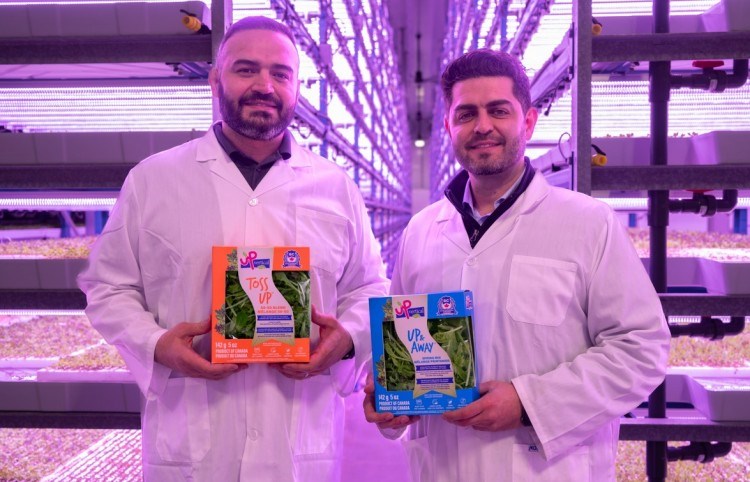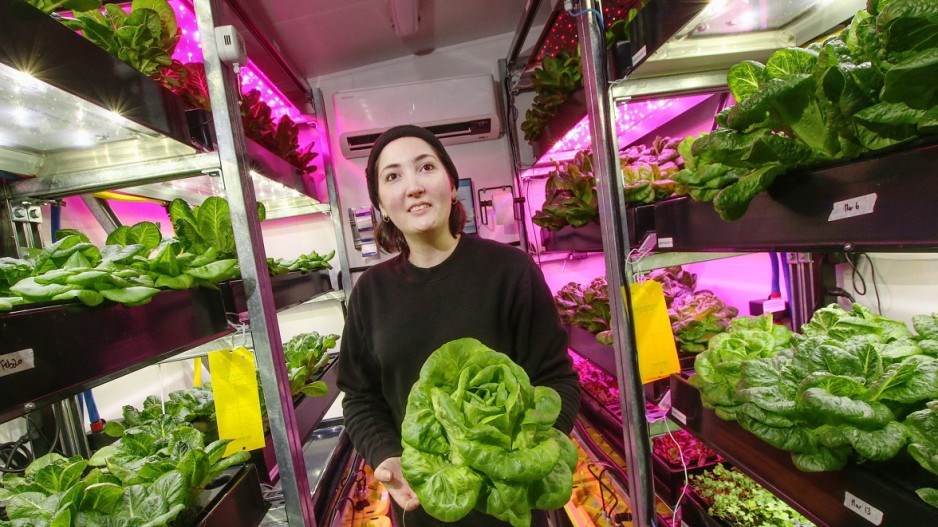Entrepreneurs in B.C.’s vertical-farming sector envisage opportunity in their niche to be sky-high, thanks to the B.C. government changing regulations, labour shortages in traditional agriculture and crumbling supply chains between the province and California.
An ambitious, fully mechanized, vertical-farming operation launched in March in Pitt Meadows, while entrepreneurs at other ventures are leasing space to expand farming operations and are selling equipment to enable others who aspire to enter the burgeoning field.
“We will see almost all leafy greens and small fruit produced in greenhouses or vertical operations within 10 years or so because there simply won’t be options,” said Lenore Newman, director of the Food and Agriculture Institute at the University of the Fraser Valley.
“California’s dominance is being challenged by a perfect storm of climate, protectionist policy, labour and other challenges.”
Some vertical farms have long existed in small buildings on B.C.’s Agricultural Land Reserve (ALR).
In early 2022, the B.C. government clarified that vertical farms are permitted in the ALR, and that larger operations are allowed. This has opened the floodgates for the sector to expand even though there are some challenges for aspiring vertical-farming entrepreneurs, such as:
• high upfront costs;
• the need for lots of energy; and
• technical expertise.
Some businesses, such as QuantoTech Solutions Ltd., continue to opt to lease square footage in more expensive industrial buildings because the sites are closer to population centres.
CEO Alycia van der Gracht told BIV that she started her venture in partnership with the University of the Fraser Valley. She then moved to a 5,000-square-foot site in Port Coquitlam, where half the site is used for vertical farming and the rest is a manufacturing facility for vertical-farming equipment.
She farms full heads of lettuce, and other produce that she packages sustainably and sells through the online shopping site directfood.store, she said.
She has so far generated thousands of dollars’ worth of sales for her produce, while a much bigger source of revenue has been what she calls “plug and play” micro-farms, which are 10 feet by 12 feet, and are ideal for sites in remote, 1,000-person communities that lack sources of fresh produce, she said.
Van der Gracht has sold four of those micro-farms, with each one selling for about $150,000, she said.
She is finalizing lease arrangements for a 20,000-square-foot indoor-farming facility near the corner of Cambie Street and West 6th Avenue, where she hopes to move into by fall.
She intends to use that site entirely to grow produce and not to manufacture equipment. The equipment-manufacturing side of her business is also set to expand, however, thanks to likely capital from Saskatchewan investors, she said.
“We have over $10 million in our pipeline for just the equipment sales so we will be expanding both avenues [for revenue,]” she said.
Other entrepreneurs are ramping up vertical-farmed food production, and similarly have big plans.
Up Vertical Farms launched production in March at its fully automated, custom-built, vertical-farming facility in Pitt Meadows.
Brothers Shahram and Bahram Rashti founded and financed the multimillion-dollar operation that is in a 50,000-square-foot building on 10 acres of ALR land, and they designed the company’s equipment, CEO Bahram Rashti told BIV.

(Image: Up Vertical Farms co-founders Shahram (left) and brother Bahram Rashti hold some of their salad greens | Submitted)
Workers pour seeds into a machine. Mechanization takes over from there.
Equipment sprinkles seeds on trays that are 40 metres long and 1.2 metres wide, he said.
The automated system then places the growing platforms in racks that can hold up to 12 trays. Three racks are currently in operation, and there are another six racks that the brothers plan to soon start using.
Their plan is to expand their number of operating racks to 16, Rashti said.
Growing time varies by product, but for salad greens the growing time is about three weeks. No pesticides are needed, and no human hands contaminate the products, Rashti said.
Equipment grabs trays and loads them into a cutter that chops off the leafy greens. Other equipment segments the cuttings into even portions and puts them into bags.
The brothers are selling their salad greens through the Coquitlam-based, global food-distribution giant Oppenheimer Group, and has products on store shelves at retailers such as Fresh Street Market and IGA, Rashti said.
“We’ll have products into all the [Oppenheimer] distribution centers for B.C., Alberta, Manitoba,” he added.
Rashti anticipates millions of dollars in revenue this year, and rapid expansion after that.
Up Vertical Farms and QuantoTech are two of many competitors seeking to gain market share in this emerging agricultural sector.
“There are at least a half dozen serious players on the growing and technology side [of vertical farming] that are expanding rapidly,” Newman said.
B.C.’s Ministry of Agriculture estimates that there are approximately 150 agritech companies in the province, although not all are in vertical farming.
Newman said B.C.’s regulatory amendments to allow more vertical farming in the ALR has helped these players, but hurdles remain.
“These include tax challenges, some trouble with farm status, and struggles with marketing boards,” she said.
“B.C. is a very regulated place, and there are many regulations that need to be updated to reflect the new industry.”•




